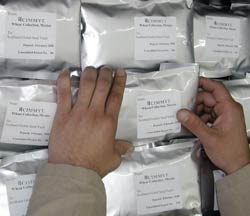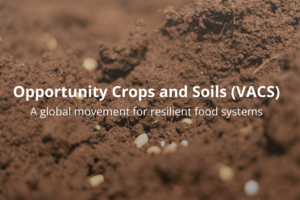 CIMMYT recently sent three tons of maize and wheat seed to a “doomsday vault” near the North Pole to keep it—and the valuable genetic diversity it embodies—safe for future generations.
CIMMYT recently sent three tons of maize and wheat seed to a “doomsday vault” near the North Pole to keep it—and the valuable genetic diversity it embodies—safe for future generations.
On 22 January 2008, CIMMYT sent more than 160 boxes of seed for long-term deposit in the Svalbard Global Seed Vault, Norway. The shipment comprised 10,000 seed collections of maize and 47,000 of wheat, held in trust by CIMMYT, and weighed around 3 tons in all. “This represents roughly a third of the center’s entire collection of crop genetic resources,” says Tom Payne, head of wheat genetic resources at CIMMYT. The shipment was part of more than 230,000 seed samples of crop varieties sent this month for storage in the vault, from germplasm banks of the Consultative Group on International Agricultural Research (CGIAR), NGOs, and national program collections.
Sheltering frail seed
As any farmer knows, seed is the basis of the world’s food supply. For plant breeders, seed also holds the genetic diversity needed to defend crops against adverse conditions, like drought and heat, or against damaging pests and diseases. But, whereas genetic diversity strengthens crops against threats, the seed that bears it is relatively vulnerable. In 1998, for example, Hurricane Mitch’s floodwaters destroyed the maize seed of Honduran farmers and of a national institution in charge of seed. In another case, during Latin America’s “lost decade” economic crisis of the 1980s, many national seed banks lacked funds to maintain adequately unique collections of native maize landraces no longer grown in farmers’ fields.
“In both instances, we helped replenish or regenerate the lost or endangered seed collections, but these and other cases illustrate the natural fragility of seed and the need for multiple safeguards,” says Suketoshi Taba, head of maize genetic resources at CIMMYT. The center’s own seed collections are held in constant low-temperature and low-humidity conditions in a concrete bunker at CIMMYT’s El Batán, Mexico, facilities. They are secured against earthquakes, power outages, insect or rodent damage, and other threats.
Food and diversity for future generations
The Svalbard vault, which will open officially on 27 February 2008, provides another level of security. It was built by the Norwegian government as a service to the global community, and a Rome-based international NGO, the Global Crop Diversity Trust, will fund its operation. Its aim is to ensure that seed collections remain safe against cataclysmic events, such as a nuclear war, natural disasters, accidents, mismanagement, or short-sighted budget cuts. Carved into rock and permafrost on an island where polar bears roam, the vault can conserve seed for hundreds and, in the case of some crop species, thousands of years.
CIMMYT’s own germplasm bank conserves more than 140,000 collections of wheat and its relatives from over 100 countries—the largest unified collection in the world for a single crop. For maize, the center conserves more than 25,000 unique seed collections, including the world’s largest store of maize landraces (traditional farmer varieties), along with samples of the wild relatives teosinte and Tripsacum spp. and of improved varieties. The maize collections represent nearly 90% of maize diversity in the Americas, the hemisphere of origin for the crop. “Most of the seed collections are held ‘in trust’—that is, under long-term storage for the benefit of humanity and free from any intellectual property restrictions,” according to Masa Iwanaga, CIMMYT Director General. CIMMYT also observes the terms of the International Treaty on Plant Genetic Resources for Food and Agriculture, signed in 2004.
Occasionally a source to replenish partners’ collections in cases of catastrophe, CIMMYT germplasm bank collections are most often used for the center’s own research and the work of others—each year CIMMYT typically ships more than 5,000 seed samples, in response to requests from hundreds of researchers in dozens of countries worldwide. The collections also furnish useful genes for resistance to diseases and pests of both crops, as well as tolerance to constraints such as drought or poor soils.
“The maize seed we sent to Svalbard included collections backed up at CIMMYT over the last 15 years, as part of a cooperative program to regenerate endangered seed from Latin American germplasm banks,” says Taba. The wheat shipment to the vault comprised samples from collections regenerated over the past two years, according to Payne. “We’ll continue sending back-ups of regenerated collections to Svalbard each year, until the entire CIMMYT maize and wheat stores are represented in the vault holdings,” says Payne.
 Capacity development
Capacity development 

